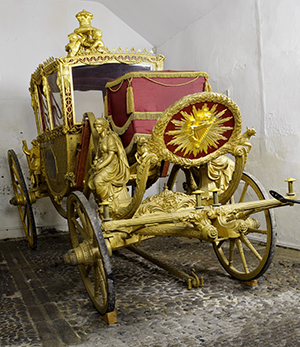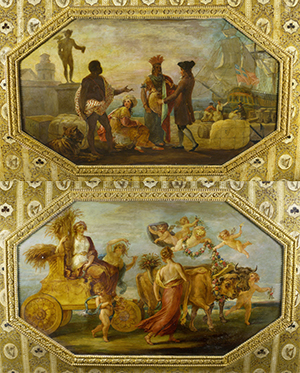Lord chancellor’s coach
Published in Artefacts, Issue 6 (November/December 2016), Volume 24By Lar Joye

Above: Lord Chancellor Fitzgibbon’s coach (from the front), manufactured in London in 1790 for £7,000.
The oldest is the state coach of the lord chancellor of Ireland, John Fitzgibbon, manufactured in London in 1790 for £7,000. Fitzgibbon was a controversial man who was involved in putting down the 1798 Rebellion and was very much in favour of the Act of Union of 1800. Unlike the lord mayor’s carriage, which was built in Dublin, Fitzgibbon had his carriage made in London, which caused great upset in Dublin (see HI 17.3, May/June 2009, pp 22–3). The coach is an excellent example of English craftsmanship, expensively carved and gilded, with panels painted by an English artist, William Hamilton.

Above: The coach is an excellent example of English craftsmanship, expensively carved and gilded, with panels painted by English artist William Hamilton.
The carriage was only used for state occasions, such as the king’s birthday, until Fitzgibbon’s death in 1802. In 1791, when Fitzgibbon was visiting the lord lieutenant in Dublin Castle with the members of the House of Lords, the roof of the carriage was badly damaged going through the gate of the Lower Yard, and ‘the ground was strewed with the fragments of the splendid structure’.
After 1802 the carriage disappeared until it was purchased by the South Kensington Museum in 1866. It was subsequently lent to the National Museum in Dublin; when the original institution opened in 1890, it was displayed in the main entrance for many years after. The Museum bought the carriage in 1949. In the 1980s it was restored by a team led by John Teahan, and for the last 30 years it has been on loan to Newbridge House, Co. Dublin. The carriage is currently back in the National Museum while Newbridge House is undergoing a major refurbishment.
Lar Joye is curator of military history at the National Museum of Ireland.
















